-
History & Society
- Education in Pre-war Hong Kong
- History of Taikoo Sugar Refinery
- Hong Kong Products Exhibition
- Local Festivals Around the Year
- Post-war Industries
- Pre-war Industry
- The Hong Kong Jockey Club Archives
- Tin Hau Festival
- Memories We Share: Hong Kong in the 1960s and 1970s
- History in Miniature: The 150th Anniversary of Stamp Issuance in Hong Kong
- A Partnership with the People: KAAA and Post-war Agricultural Hong Kong
- The Oral Legacies (I) - Intangible Cultural Heritage of Hong Kong
- Hong Kong Currency
- Hong Kong, Benevolent City: Tung Wah and the Growth of Chinese Communities
- The Oral Legacies Series II: the Representative List of the Intangible Cultural Heritage of Hong Kong
- Braving the Storm: Hong Kong under Japanese Occupation
- A Century of Fashion: Hong Kong Cheongsam Story
Geography & EnvironmentArt & Culture- Calendar Posters of Kwan Wai-nung
- Festival of Hong Kong
- Ho Sau: Poetic Photography of Daily Life
- Hong Kong Cemetery
- Sketches by Kong Kai-ming
- The Culture of Bamboo Scaffolding
- The Legend of Silk and Wood: A Hong Kong Qin Story
- Journeys of Leung Ping Kwan
- From Soya Bean Milk To Pu'er Tea
- Applauding Hong Kong Pop Legend: Roman Tam
- 他 FASHION 傳奇 EDDIE LAU 她 IMAGE 百變 劉培基
- A Eulogy of Hong Kong Landscape in Painting: The Art of Huang Bore
- Imprint of the Heart: Artistic Journey of Huang Xinbo
- Porcelain and Painting
- A Voice for the Ages, a Master of his Art – A Tribute to Lam Kar Sing
- Memories of Renowned Lyricist: Richard Lam Chun Keung's Manuscripts
- Seal Carving in Lingnan
- Literary Giant - Jin Yong and Louis Cha
Communication & Media- Hong Kong Historical Postcards
- Shaw Brothers’ Movies
- Transcending Space and Time – Early Cinematic Experience of Hong Kong
- Remembrance of the Avant-Garde: Archival Camera Collection
- Down Memory Lane: Movie Theatres of the Olden Days
- 90 Years of Public Service Broadcasting in Hong Kong
- Multifarious Arrays of Weaponry in Hong Kong Cinema
-
History & SocietyGeography & EnvironmentArt & Culture
-
View Oral History RecordsFeatured StoriesAbout Hong Kong Voices
-
Hong Kong Memory
Images
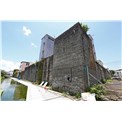
-
Kat Hing Wai
Kat Hing Wai was built during the Chenghua reign (1465-1487) of the Ming dynasty. The walls were constructed in the early Qing period with watchtowers and gun loopholes on all four corners and a pair of chained-ring iron gates at the main entrance. The enclosing walls were once surrounded by a moat. In 1899, the iron gates were violently removed by the British when the New Territories were leased to them. Later a squire named Tang Pak Kau sent a petition to the Hong Kong government, and the gates were finally returned and reinstalled in 1925.
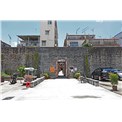
-
Enclosing wall and main entrance of Kat Hing Wai
Enclosing wall and main entrance of Kat Hing Wai at present.
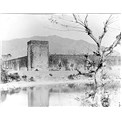
-
Enclosing wall, watchtower and moat of Kat Hing Wai
Enclosing wall, watchtower and moat of Kat Hing Wai in the 1900s.
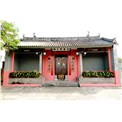
-
Tang Tsing Lok Ancestral Hall
Tang Tsing Lok Ancestral Hall was built between the late Ming and early Qing periods to commemorate Tang Tsing Lok, the seventeenth generation ancestor of the Tang clan in Guangdong Province. This grey brick building belongs to an architectural style that comprises three halls with two courtyards. The ancestral hall has been used by the descendants of Tang Tsing Lok as a place for worship, festivals and clan gatherings. The lantern-lighting ceremony for newborn male offspring is still held here annually from the twelfth to the fifteenth days of the first lunar month.
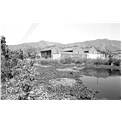
-
Tang Tsing Lok Ancestral Hall in the past
Tang Tsing Lok Ancestral Hall, a three-hall, two-courtyard building, 1977.
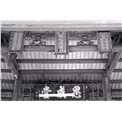
-
Boards at the middle hall of Tang Tsing Lok Ancestral Hall
Boards hung at the middle hall of Tang Tsing Lok Ancestral Hall in 1978. The three smaller ones were honorific boards and the large one was inscribed with three characters "Shi Shing Tong", which is the name of the ancestral hall.
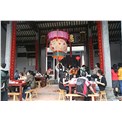
-
Lantern-lighting ceremony at Tang Tsing Lok Ancestral Hall
Lantern-lighting ceremony at Tang Tsing Lok Ancestral Hall.
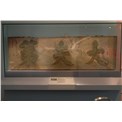
-
Wooden plaque at the main entrance of Tai Fu Tai
Wooden plaque at the main entrance of Tai Fu Tai in San Tin, Yuen Long.
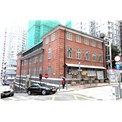
-
Old Tsan Yuk Hospital
The old Tsan Yuk Hospital, built in 1922, was the first maternity hospital for Chinese in Hong Kong. Its red brick construction is a form of Neo-classical architecture. Later, the hospital accommodated an academic and placement hospital for the Department of Obstetrics & Gynaecology of The University of Hong Kong. In 1955, the hospital was moved to a new location, and in 1973, the building was converted into Western Community Centre.
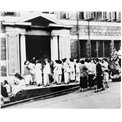
-
Pregnant women waiting for medical consultation at Tsan Yuk Hospital
Pregnant women queuing outside for medical consultation at Tsan Yuk Hospital.
Copyright © 2012 Hong Kong Memory. All rights reserved.
| Set Name |





